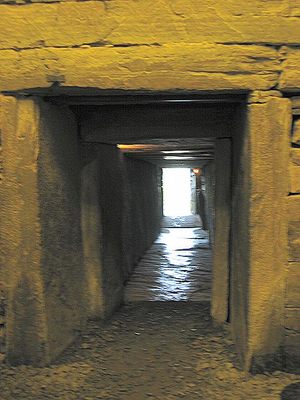About
The "Heart of Neolithic Orkney," this impressive cairn is an archaeological treasure both because it is so well preserved and because it is so well vandalized.
Maeshowe is a Neolithic passage grave and chamber cairn in the Orkney Islands north of Scotland. It was built around 3000 BCE and is aligned in various ways with other Neolithic sites in the Orkneys; the entrance to the Barnhouse settlement directly faces Maeshowe, the entrance of which points to the Barnhouse Stone. Additionally, there is a stone "gate" which frames the cairn when viewed from the nearby Stones of Stenness. The narrow passage of Maeshowe also aligns with the rear wall of the inner chamber and the opening of the rear side chamber so that it is illuminated by the last, red rays of the setting sun on the winter solstice.
Standing 25-feet tall and about 120 feet in diameter with a three-foot square entrance, Maeshowe has a large, 13-foot-tall central chamber with three smaller side chambers. These side chambers, really no more than alcoves in the walls, probably once contained the burial remains and goods, but they were sacked whenever their seal stones were initially removed. The lower parts of the walls of these chambers (and the entrance passage) are constructed from large, flat flagstones weighing up to 30 tons, and the roof structure is supported by massive buttresses at each corner. As the cairn itself is surrounded by an earthen ring and there is evidence that Maeshowe was built over a pre-existing site, a popular theory as to its construction is that many of the stones used to build it were actually part of an earlier standing stones site at that location. Since the man-hours required to make Maeshowe are estimated at up to 100,000 hours, and it is significantly more impressive than slightly earlier structures, it is also believed that this is a sign that the simple village-dwelling Neolithic peoples had begun to develop a class system or an "elite" caste had emerged.
While Maeshowe is famous for being astonishingly well built and preserved (no thanks to modern discoverer and notably dubious excavator James Farrer, who tried to enter through the top of the structure and collapsed the roof) passage grave, it is equally important and renowned for its vandalization. In the 12th century, the tomb was looted by the vikings Earl Harald Haddadarson and Earl Ragnvald of Møre. They left behind something far more valuable than anything they might have taken, however; more than 30 runic inscriptions (the largest collection in the world) were made in the central chamber. Although it is one of the earliest known instances of graffiti, not much actual knowledge is contained in these carvings except for the identities of their authors, as many of the (less vulgar) messages literally read "[insert name] was here." They proved to be instrumental in the decoding of the runic language, however, as not nearly so many inscriptions had ever been found together in context.
Related Tags
Know Before You Go
At the corner of the A965 and Stoneyhill Rd. A visitor center is just across the street. To gain access to site, one has to purchase a ticket from the visitor center, and then be guided over by a bus. It is advised to purchase tickets in advance, as group size is limited. No photography of the interior is permitted.
Flavors of Scotland: Beyond the Haggis
Smoked seafood, single malt whisky, and warm hospitality.
Book NowCommunity Contributors
Added By
Published
April 18, 2016































